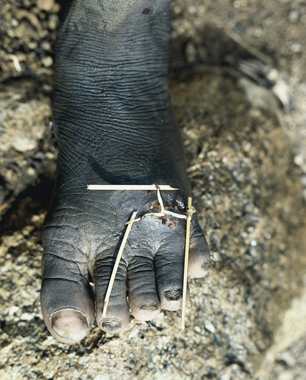5 The guinea worm eradication campaign
Guinea worm disease, or dracunculiasis, is caused by the nematode worm Dracunculus medinensis – literally the ‘little dragon of Medina’. It is the largest tissue parasite to affect humans and the only exclusively waterborne pathogen. Note that the terms ‘guinea worm disease’ and ‘dracunculiasis’ are used interchangeably in the literature on this condition; you will also find ‘Guinea worm’ capitalised in some sources.
The association of the worm with a dragon may be due to the fiery, burning pain experienced at the site where the worm emerges from the body, most often in the lower leg or foot. Like smallpox, it has been known since antiquity and evidence of guinea worms has been found in Egyptian mummies.
The practice of ‘winding’ the emerging worms onto a stick (Figure 17), which has been practised for at least 2000 years, may even have given rise to the symbolic emblem of the medical profession – a staff entwined by two serpents.

The campaign to eradicate guinea worms from the world has been chosen as the final example in this course because it illustrates many of the key features of the public health approach to controlling infectious disease – but particularly the importance of community action and the power of low-cost interventions.
